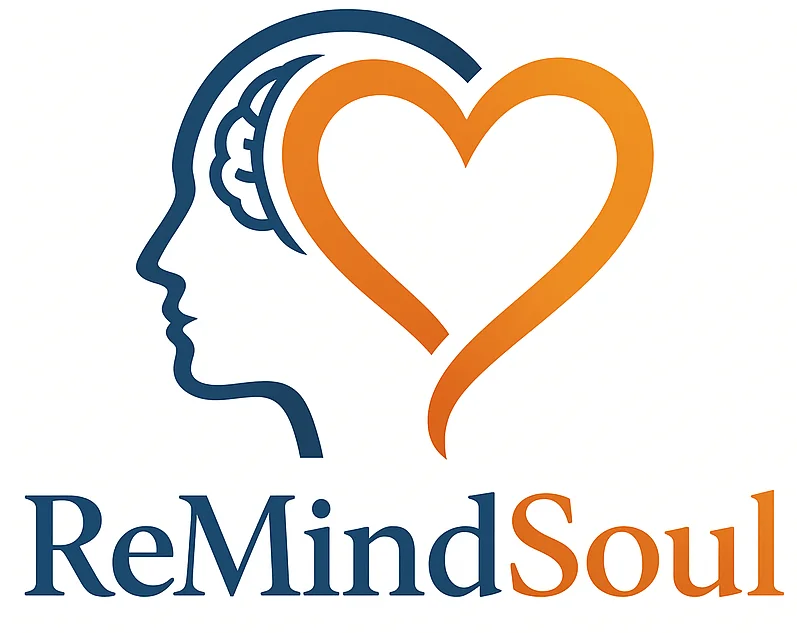Healing Methods and Techniques 🕊️
Discover powerful emotional healing methods including EFT tapping, Body Code, energy work, and somatic techniques to release trauma and restore balance naturally.
Healing Methods: A Complete Guide to Mental and Emotional Health
This guide helps you understand and apply practical emotional healing tools that engage your whole being. While these practices are powerful on their own, they work best as complements to professional therapy, trauma-informed support, or medical care when needed.

Understanding Your Healing Journey
If you’ve ever felt stuck in old pain or repeating patterns, healing methods can help you reconnect with your emotional and physical balance.
Healing isn’t something that simply happens to you. It is “a personal journey you actively shape,” guided by your intuition and supported by practices that resonate with your unique needs.
You become an active participant in your own transformation, choosing approaches that:
- Honor your unique experiences and timing.
- Help you release what no longer serves you.
- Rebuild trust in your body, emotions, and intuition.
Remember, healing is non-linear. It unfolds in cycles of reflection, release, and renewal. Progress may not always feel steady, yet “each step contributes to your growth and integration.”
Healing Methods and Techniques
These practices are here to help you reconnect with your mind, body, and energy, fostering balance, resilience, and deeper self-awareness.
What Are Healing Modalities and Techniques?
Healing modalities and techniques are intentional practices that support the whole person—body, mind, and energy. These approaches recognize that emotional wounds don’t exist only in your thoughts; they are also stored within your nervous system, muscles, and energetic field.
When you integrate body-mind-energy approaches, you’re not just managing symptoms. You’re “fostering authentic emotional resilience from within.”
Healing Modalities Examples
- Somatic Therapy: Focuses on releasing trauma stored in the body through awareness, movement, and breath.
- Energy Healing (e.g., Reiki, Chakra Balancing): Clears energetic blockages to restore flow and harmony.
- Mindfulness and Meditation: Cultivates awareness and calm by training your attention and emotional regulation.
- Breathwork: Uses conscious breathing to release emotional blockages and activate relaxation responses.
- Sound Therapy: Employs vibration and frequency to restore emotional and energetic balance.
- Art or Expressive Therapy: Channels emotions creatively to process and express what words cannot.
Healing Techniques Examples
- Grounding Exercises: Help you reconnect with the present moment through touch, breath, or sensory focus.
- Body Scanning: Increases awareness of physical sensations and areas of tension in the body.
- Journaling: Provides a safe space to explore emotions, patterns, and insights.
- Affirmations: Reprogram thought patterns with positive, empowering statements.
- Visualization: Uses mental imagery to promote relaxation, healing, and emotional clarity.
- Movement Practices (Yoga, Tai Chi, Qigong): Combine breath, awareness, and gentle motion to restore balance and flow.
By working with multiple dimensions of your being at once, you create “lasting transformation rather than temporary relief.”
Holistic Healing Methods
You might be wondering why different techniques are needed. Can’t you just think your way through emotional pain? The truth is, healing takes more than mental understanding alone. Your body holds memories that your conscious mind may have forgotten, and your energy system responds to stress in quiet, subtle ways you might not even notice.
That’s why holistic healing methods, which honor the connection between your physical sensations, emotional patterns, and energetic flow, create lasting transformation instead of temporary relief.
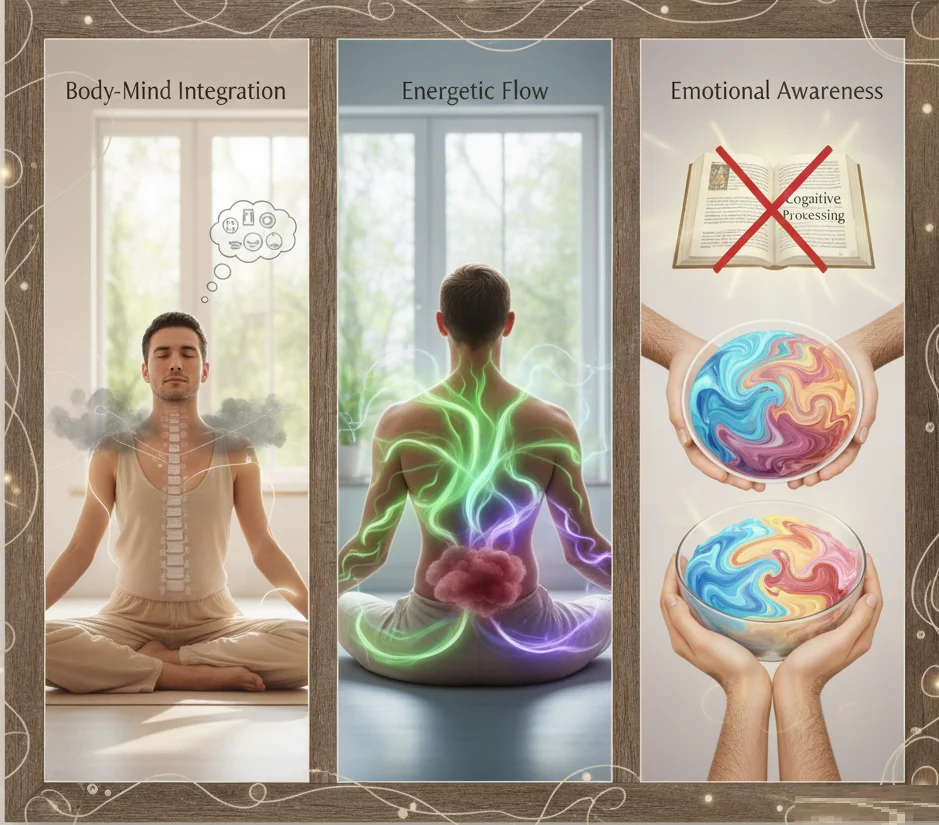
Why Holistic Healing Works
Holistic methods view you as a whole, interconnected being. Instead of isolating your mind from your body or emotions, they treat these parts as mutually influencing systems.
When you integrate body-mind-energy approaches, you build genuine emotional resilience—because healing unfolds on multiple levels simultaneously.
Core Insights
- Body-Mind Integration: Your body reflects what your mind feels and believes; tension, posture, and breath all reveal emotional states.
- Energetic Flow: Stagnant or blocked energy often mirrors suppressed emotion or unresolved experiences.
- Emotional Awareness: Understanding feelings cognitively isn’t enough—you must also feel and process them through the body.
- Multilayered Healing: Deep change happens when thoughts, emotions, and sensations are addressed together as one unified system.
Key Holistic Healing Techniques
Below are some foundational holistic methods that bridge your emotional, physical, and energetic systems, empowering you to take an active role in your healing journey.
1. Energy Work
- Focuses on clearing, balancing, and restoring your subtle energy system.
- Includes practices such as Reiki, chakra balancing, and pranic healing.
Benefits: Increases vitality, emotional clarity, and inner peace.
2. Emotional Freedom Technique (EFT / Tapping)
- Combines gentle tapping on acupressure points with verbal acknowledgment of emotions.
- Sends calming signals to the nervous system and helps reprogram stress responses.
Benefits: Reduces anxiety, fear, and emotional reactivity while promoting self-acceptance.
3. Breathwork
- Uses intentional breathing patterns to release tension and activate relaxation.
- Connects body and mind, allowing emotions to move and release safely.
Benefits: Improves emotional regulation, oxygen flow, and inner balance.
4. Somatic Awareness
- Encourages mindful attention to bodily sensations to process stored emotions.
- Helps identify where pain, stress, or trauma are held so they can be released gently.
Benefits: Builds self-trust, body awareness, and emotional grounding.
5. Intuitive Journaling
- Involves writing freely from an intuitive place without censoring or overthinking.
- Allows emotions and insights to surface naturally.
Benefits: Offers clarity, release, and connection to your inner wisdom.
6. Sound Healing
- Uses vibration and frequency through instruments like singing bowls or tuning forks.
- Helps the nervous system reset and restores energetic harmony.
Benefits: Promotes deep relaxation, emotional balance, and mental clarity.
7. Mindfulness and Meditation
- Develops presence and awareness of thoughts, emotions, and sensations.
- Encourages acceptance and reduces reactivity.
Benefits: Enhances calm, focus, and emotional resilience.
8. Movement-Based Healing (Yoga, Qigong, Tai Chi)
- Combines breath, movement, and mindfulness to restore flow and connection.
- Supports physical release and energetic balance.
Benefits: Increases flexibility, vitality, and inner harmony.
9. Visualization and Guided Imagery
- Uses mental imagery to promote healing and transformation.
- Helps shift emotional and energetic patterns through focused intention.
Benefits: Enhances relaxation, optimism, and self-healing capacity.
Body Code Healing
The Body Code, developed by Dr. Bradley Nelson, is a comprehensive energy healing system designed to identify and release trapped energies that create imbalance within your body.
Through muscle testing, practitioners can pinpoint where emotional energy has become lodged or stuck, often uncovering the hidden roots of both physical tension and emotional distress.
This method recognizes that your body stores unprocessed emotions as energetic imprints. These trapped emotions don’t simply fade away—they remain in your system, influencing your physical sensations, emotional reactions, and overall sense of well-being.

The Body Code Healing System
The Body Code provides a structured framework for identifying energetic and physical imbalances across six key areas:
- Energies: Trapped emotions, post-traumatic stress, or psychic energies.
- Circuits and Systems: Imbalances in organs, glands, or energy pathways.
- Toxins: Environmental or internal toxins disrupting energetic flow.
- Pathogens: Bacterial, viral, or energetic imbalances affecting vitality.
- Misalignments: Structural or energetic misalignments within the body.
- Nutrition and Lifestyle: Deficiencies or habits that weaken your energy field.
Rather than guessing what might be wrong, this system uses direct communication with your body’s innate wisdom to reveal what requires attention and healing.
Benefits of Body Code Healing
Clearing trapped energies with the Body Code can create a profound sense of lightness and calm. As you release emotional and energetic baggage, you may feel more connected, open, and balanced.
Common Benefits Include:
- Greater emotional stability and reduced reactivity.
- Relief from physical pain or chronic tension.
- Improved energy flow and sustained vitality.
- Increased self-awareness of recurring emotional patterns.
- A deeper sense of harmony and ease in daily life.
Emotion Code Healing
The Emotion Code, created by Dr. Bradley Nelson, focuses specifically on releasing trapped emotions—energetic residues of past experiences that were never fully felt or processed.
While the Body Code addresses six categories of imbalance, the Emotion Code hones in on one: emotional energy. These trapped emotions remain lodged in your system, subtly influencing your thoughts, behaviors, and physical health.

Emotion Code Healing Test
The Emotion Code healing test uses muscle testing (applied kinesiology) to communicate directly with your subconscious mind.
During a session, the practitioner asks yes-or-no questions about trapped emotions while observing a muscle response:
- A strong response indicates alignment or “yes.”
- A weak response suggests imbalance or “no.”
This method bypasses the conscious mind to reveal stored emotional data that your body still carries.
Through testing, you may uncover:
- Childhood emotions from unprocessed experiences.
- Inherited emotions passed down through generations.
- Prenatal emotions absorbed before birth.
Emotion Code Self-Assessment
Answer YES or NO to identify trapped emotions:
- Do you have unexplained physical pain or discomfort?
☐ Yes ☐ No - Do you feel emotionally stuck in any area of your life?
☐ Yes ☐ No - Do you overreact to certain situations or triggers?
☐ Yes ☐ No - Do you repeat negative patterns or self-sabotage?
☐ Yes ☐ No - Do you struggle to give or receive love fully?
☐ Yes ☐ No - Do past events still heavily impact your mood?
☐ Yes ☐ No - Do you experience anxiety, depression, or numbness?
☐ Yes ☐ No
Results: 5-7 Yes = High | 3-4 Yes = Moderate | 1-2 Yes = Low | 0 Yes = Clear
Emotional Healing Therapy Technique
Emotional healing therapy techniques specifically target the feelings themselves—the raw emotional content that lives in your body and influences your daily experience.
Rather than trying to understand emotions intellectually or control them mentally, these techniques help you feel, process, and release emotions in a safe, supported way.
Emotional healing approaches include:
- EFT tapping: Directly addressing emotional intensity while sending calming signals to your nervous system
- Somatic experiencing: Tracking sensations in your body and allowing incomplete emotional responses to complete
- Emotion-focused therapy: Creating space to fully feel previously avoided emotions with therapist support
- Expressive arts therapy: Using art, music, dance, or drama to express emotions that words can’t capture
- Emotional release breathwork: Specific breathing patterns that facilitate emotional discharge
- Grief work: Acknowledging and mourning what was lost, what you never received, or what was taken from you
- Anger release practices: Safe, contained ways to express anger that’s been suppressed (like hitting pillows, tearing paper, or vocal release)
Emotion Code Healing Chart
The Emotion Code chart organizes 50 emotions into six columns and ten rows, providing a systematic map to locate trapped emotions.
Using muscle testing, you identify the relevant column and row, eventually pinpointing the specific emotion. Emotions range from abandonment and anxiety to worry and worthlessness, giving form and language to previously unseen energies.
This chart transforms the abstract idea of “trapped emotions” into something tangible—something you can name, locate, and release.
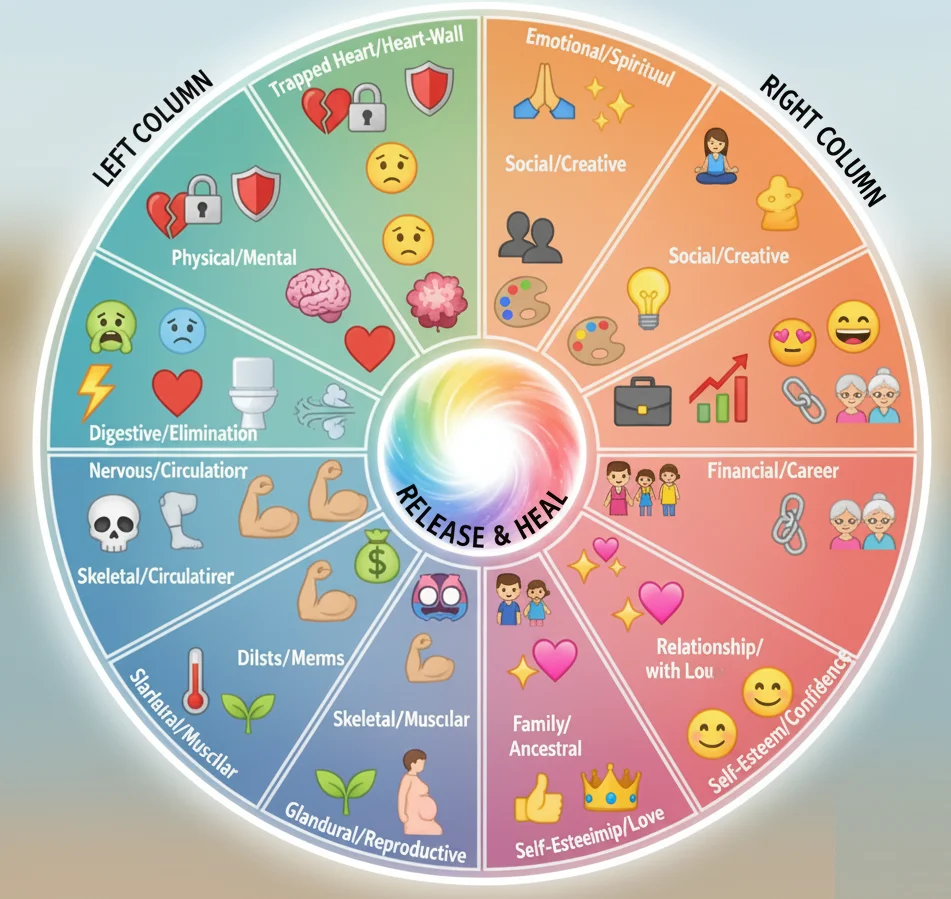
Emotional Healing Modalities
Emotional healing modalities are structured systems or frameworks of healing—often guided by trained practitioners—that provide deeper, more comprehensive therapeutic work.
They help uncover and transform root causes and patterns underlying emotional pain.
Common Emotional Healing Modalities
- Somatic Experiencing: Focuses on physical sensations to resolve trauma responses.
- Internal Family Systems (IFS): Explores inner “parts” of the self to heal emotional fragmentation.
- Trauma-Informed Yoga: Combines mindful movement and breath to gently release stored trauma.
- Energy Psychology (e.g., EFT Tapping): Merges acupressure points with emotional processing.
- Sound or Vibrational Healing: Uses frequency to regulate emotions and energy centers.
- Guided Hypnotherapy: Accesses the subconscious to reframe limiting beliefs.
- Therapeutic Touch and Reiki: Restores balance through energy channeling and intention.
Emotion Body Code
The Emotion Body Code approach teaches that every emotion has a physical expression and energetic signature. Learning this language allows you to recognize where emotions live in your body and what they’re trying to communicate.
Common emotional-physical patterns include:
- Fear / Anxiety: Tight chest, shallow breath, churning stomach, trembling, cold extremities
- Anger: Heat in face and neck, clenched jaw, tense shoulders, pounding temples, fists forming
- Sadness / Grief: Heaviness in chest, lump in throat, fatigue in limbs, hollow stomach, slumped posture
- Shame: Collapsed posture, contraction in solar plexus, desire to hide, burning face, avoiding eye contact
- Joy: Expansion in chest, lightness throughout the body, warmth at the heart, tingling limbs, buoyancy
For instance, tight shoulders may reflect carrying too much responsibility, while jaw tension often represents unspoken anger or withheld truth. These signals invite you to release what your body has been holding silently for years.
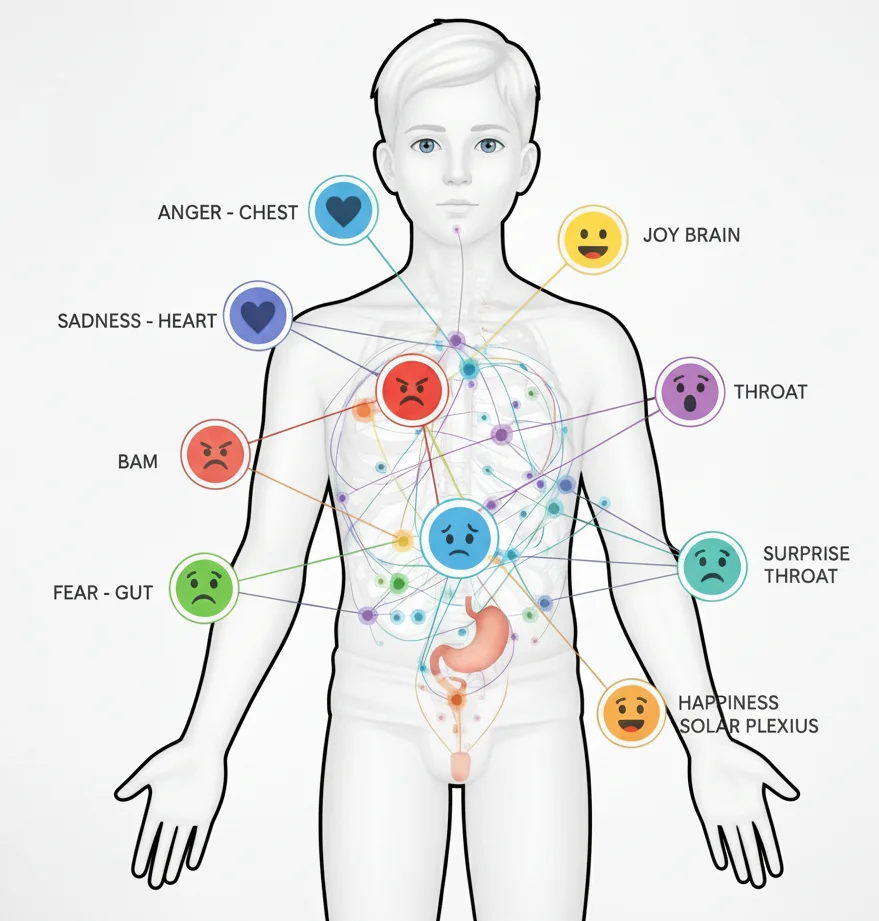
Healing Methods and Techniques Comparison
Body Code Healing vs. Emotion Code Healing vs. Emotional Body Healing vs. Emotion Body Code
1. Body Code Healing
- Origin: Developed by Dr. Bradley Nelson as an advanced system expanding on the Emotion Code.
- Main Focus: Balances physical, emotional, and energetic systems for holistic wellness.
- Core Principle: The body’s innate intelligence reveals and corrects energetic imbalances.
- Methods Used: Muscle testing, energy correction, magnetic clearing, and identifying six key imbalance areas.
- Primary Goal: Restore full-body harmony and energy flow.
- Best For: Those seeking a structured, practitioner-guided healing approach.
2. Emotion Code Healing
- Origin: Created by Dr. Bradley Nelson to identify and release trapped emotions.
- Main Focus: Clears emotional blockages that contribute to physical or emotional distress.
- Core Principle: Unprocessed emotions become trapped energy that affects health and well-being.
- Methods Used: Muscle testing, Emotion Code chart, and magnetic clearing along the governing meridian.
- Primary Goal: Release emotional baggage to promote clarity, peace, and balance.
- Best For: Individuals wanting a simple, effective, and self-guided emotional release technique.
3. Emotional Body Healing
- Origin: Draws from somatic therapy, energy psychology, mindfulness, and neuroscience.
- Main Focus: Helps you feel and process emotions fully through the body.
- Core Principle: Healing occurs through embodied awareness and compassionate presence.
- Methods Used: Somatic meditation, breathwork, mindful movement, and body awareness.
- Primary Goal: Strengthen the mind-body connection and build emotional safety.
- Best For: People seeking trauma-informed, body-centered healing practices.
4. Emotion Body Code
- Origin: Integrates principles of the Emotion Code with somatic and energetic awareness.
- Main Focus: Recognizes how emotions manifest physically and energetically in the body.
- Core Principle: Each emotion carries a physical location and energetic signature.
- Methods Used: Body mapping, gentle movement, visualization, and mindful inquiry.
- Primary Goal: Decode emotional signals and release stored energy through awareness.
- Best For: Those drawn to intuitive, body-based emotional decoding and self-awareness.
Energy Healing Techniques
Your body, mind, and energy aren’t separate—they constantly communicate with one another. When you’re under emotional stress, your body tenses, your energy stagnates, and your mind feels heavy or clouded.
When your nervous system stays activated for too long, emotions become overwhelming and hard to regulate.
Emotional energy affects both your physical and mental health in real, tangible ways.
- Unprocessed anger may show up as tension in your jaw or shoulders.
- Unexpressed grief often feels like heaviness in the chest or shortness of breath.
- Shame or guilt can settle as tightness in the stomach.

Energy Healing Techniques for Beginners
Start with gentle, accessible methods that reconnect you to your body’s natural energy flow.
1. Energy Scanning
- Close your eyes and slowly bring awareness through your body from head to toe.
- Notice warmth, tightness, or tingling. Wherever energy feels heavy, breathe into that space.
Purpose: Builds awareness and identifies where emotions are stored.
2. Grounding and Centering
- Visualize roots extending from your feet into the earth. Inhale stability, exhale tension.
Purpose: Anchors your energy and promotes calm presence.
3. Breath and Energy Flow
- Inhale deeply through the nose, imagining light entering your body.
- Exhale through the mouth, releasing heaviness or stress.
Purpose: Restores energetic circulation and emotional clarity.
4. Hand Energy Healing
- Rub your palms together to activate warmth. Place them over your heart or tense areas.
- Visualize light and warmth radiating through your hands.
Purpose: Promotes relaxation and self-soothing.
5. Visualization
- Imagine a soft, healing light—white, gold, or green—moving through your body, clearing emotional residue.
Purpose: Rebalances your energetic system and fosters emotional harmony.
Energy Healing at Home
You can practice these methods anytime, anywhere—no special tools needed.
Tips for Home Practice
- Create a calm, uncluttered space with soft lighting.
- Set an intention before starting (e.g., “I release tension and welcome peace.”)
- Combine breathwork, visualization, or gentle touch for deeper healing.
- Drink water and journal afterward to integrate insights.
With consistency, energy healing helps you release emotional tension, restore flow, and build resilience—bringing balance to every layer of your being.
EFT for depression
Emotional Freedom Technique (EFT), commonly known as “tapping,” is an evidence-based method that blends ancient Chinese acupressure with modern psychology.
By gently tapping on specific meridian points on your face and body while focusing on emotional challenges, you send calming signals to the amygdala—the brain’s stress and alarm center. This helps reduce emotional intensity, lower physiological stress, and restore inner calm.
Research supports EFT’s benefits for depression, anxiety, PTSD, and stress reduction. The process combines mindful awareness with physical engagement, helping you regulate your nervous system, reduce emotional overwhelm, and develop greater self-acceptance.
A common setup phrase during tapping is:
“Even though I feel low, I deeply and completely accept myself.”
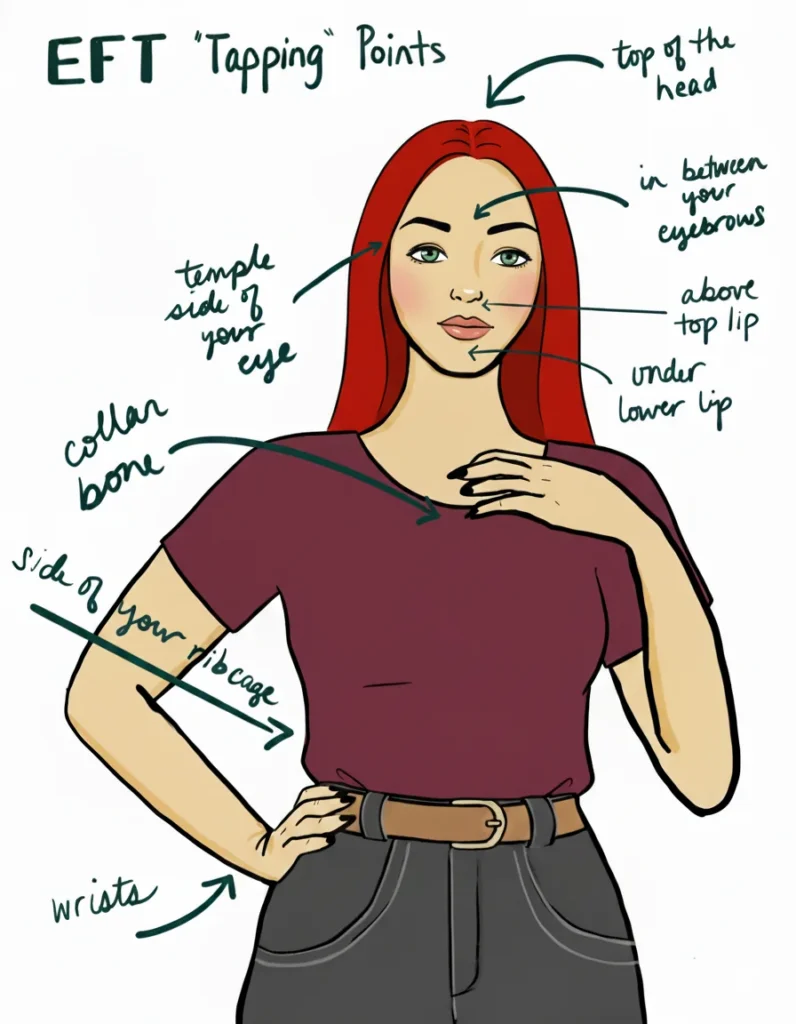
EFT Method
EFT works by addressing energetic disruptions that occur when you experience emotional distress.
Unlike traditional talk therapy, which focuses mainly on thoughts and behaviors, EFT acknowledges the mind-body connection—that emotions create physical responses in your body.
When you tap on meridian points while voicing your emotional truth, you retrain your stress response, calming both your body and mind.
What makes EFT accessible:
- No special tools or environment required.
- Can be practiced anywhere—at home, at work, or before a stressful event.
- Integrates touch, voice, and intention for multi-level healing.
This simplicity makes EFT a powerful self-help tool for emotional regulation.
EFT for Depression and Anxiety
EFT is especially effective for depression and anxiety, which often reflect dysregulation of your nervous system:
- Anxiety keeps your body in a constant state of high alert (hyperarousal).
- Depression can bring energetic collapse, numbness, or fatigue.
Tapping directly impacts these physiological states. Research shows that EFT can reduce cortisol levels by up to 24% after a single hour-long session.
- For depression, EFT helps interrupt repetitive negative thoughts and gently lift emotional heaviness.
- For anxiety, it provides an immediate calming tool that restores a sense of control and presence.
You don’t have to “believe” in EFT for it to work—your body naturally responds to the rhythmic tapping and emotional acknowledgment, regardless of skepticism.
Healing EFT
Beyond depression relief, Emotional Freedom Technique (EFT) helps you manage stress, trauma memories, low self-esteem, and emotional overwhelm. By regulating your nervous system, it teaches your body to return to a state of safety and calm after emotional triggers.
You can use EFT immediately after a heated argument, during rising anxiety, before a stressful event, or to gently process painful memories. Many describe it as “resetting their emotional state” or “turning down the volume” on difficult feelings. With daily practice, tapping builds emotional resilience, helping you stay centered and grounded even during life’s challenges.
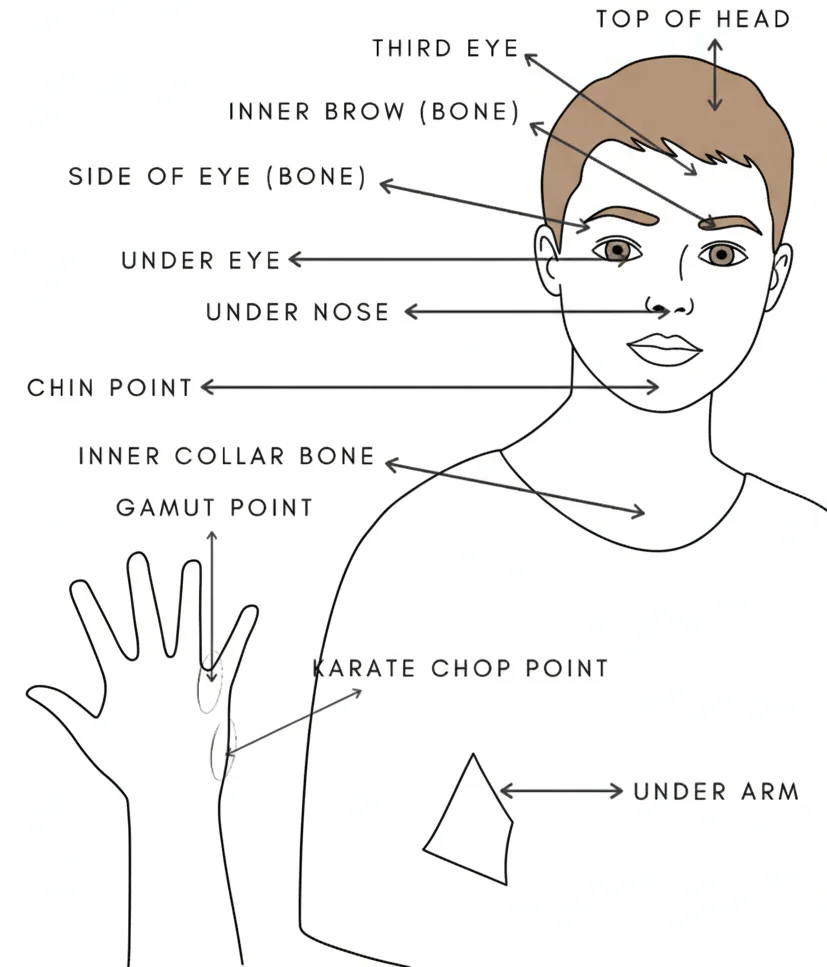
Healing EFT Meaning
At its core, EFT is more than stress relief—it’s a shift in how you relate to emotions. Instead of viewing pain as something to suppress, EFT helps you see emotions as messengers carrying wisdom about unmet needs or unresolved experiences.
Key principles of Healing EFT include:
- Your body holds emotional wisdom.
- Acceptance precedes transformation.
- Healing happens in layers, not all at once.
- You are your own healer.
Through this practice, you take agency in your healing journey, gaining a tool that’s always available—anytime, anywhere.
Healing EFT Technique
The Healing EFT technique follows a structured yet intuitive process for emotional regulation and relief:
- Identify the issue: Name the emotion or problem and rate its intensity on a 0–10 scale to track progress.
- Setup statement: While tapping the karate chop point (outer edge of the hand), repeat three times:
“Even though I feel [emotion/issue], I deeply and completely accept myself.”
- Tapping sequence: Gently tap 5–7 times on each point—top of head, eyebrow, side of eye, under eye, under nose, chin, collarbone, under arm—while speaking honestly about what you feel.
- Reassess: Rate the intensity again. Continue until your distress lowers to a 0–2 or until you sense emotional relief.
Rather than forcing positivity, EFT invites you to honor your truth as it is. This honesty allows genuine transformation.
Healing EFT Guide
When to use EFT:
- When emotions feel intense or overwhelming.
- After conflicts or triggering experiences.
- Before challenging situations to stay calm and centered.
- As a daily self-care practice for emotional balance.
- In partnership with a practitioner for deeper work.
How to craft effective statements:
- Be specific: “This anxiety about tomorrow’s meeting.”
- Start with truth, not forced positivity.
- Use natural language.
- Include body sensations: “This tightness in my chest.”
- Let statements evolve as feelings shift.
Surprising Ways to Heal Trauma Without Medication
There are many ways of healing from emotional pain, abuse, and trauma. The approaches described here—Body Code, Emotion Code, EFT, emotional body healing, somatic practices, and healing touch—represent just some of the effective ways of healing available to you.
Other ways of healing that complement these practices include:
- Talk therapy: Processing your story with a trained professional who can witness and validate your experience
- Support groups and community healing: Connecting with others who’ve experienced similar trauma, ending isolation
- Creative expression: Using art, music, dance, or writing to express what words alone cannot capture
- Nature-based healing: Spending time outdoors, recognizing your connection to something larger than your pain
- Spiritual practices: Prayer, meditation, ritual, or whatever resonates with your beliefs and connects you to meaning
- Body-based therapies: Yoga, tai chi, martial arts, or other practices that help you reclaim your body
- Animal-assisted therapy: The regulating presence of animals who offer unconditional acceptance
The most important thing is finding ways of healing that feel right for you, that honor your unique needs and circumstances. Healing is not one-size-fits-all. Your path will be unique, combining elements that speak to your specific experiences, cultural background, resources, and what resonates with your soul.
Self-Healing Therapy Technique
Self-healing therapy techniques empower you to take an active role in your own recovery rather than remaining dependent solely on external practitioners or interventions. These are practices you can implement independently, in your own time and space, at your own pace.
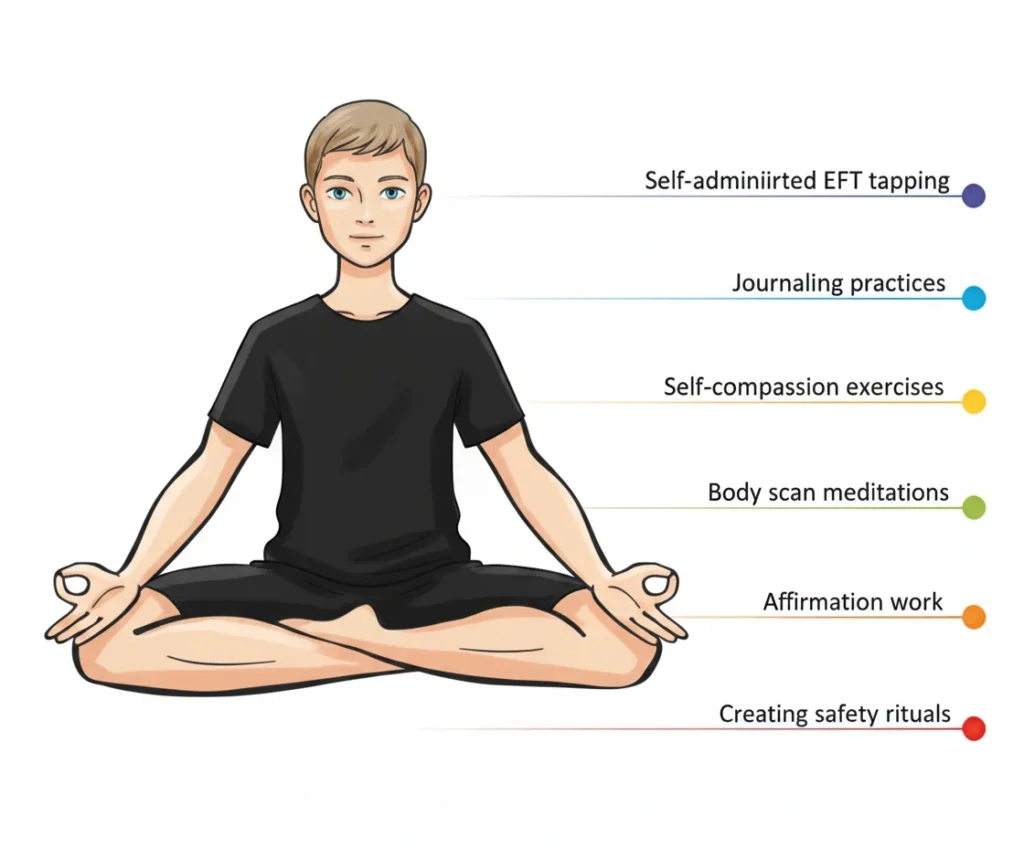
Self-healing approaches include:
- Emotional WoundsSelf-administered EFT tapping: Using the tapping sequence on yourself whenever emotional intensity arises
- Journaling practices: Free writing, letter writing to your emotions, or structured prompts that help you process experiences
- Self-compassion exercises: Speaking to yourself the way you would speak to a beloved friend going through difficulty
- Body scan meditations: Regularly checking in with physical sensations and offering presence to areas holding tension
- Affirmation work: Not to bypass real feelings, but to plant new beliefs alongside processing old wounds
- Creating safety rituals: Developing personal practices that signal to your nervous system that you’re protected and cared for
The power of self-healing techniques lies in building your sense of agency and capability. You discover that you possess internal resources
Mind Healing Therapy Technique
Mind healing therapy techniques address the cognitive and mental patterns that formed as a result of your experiences. Your mind created certain beliefs, thought patterns, and narratives to make sense of what happened to you—many of which now limit your freedom and wellbeing.
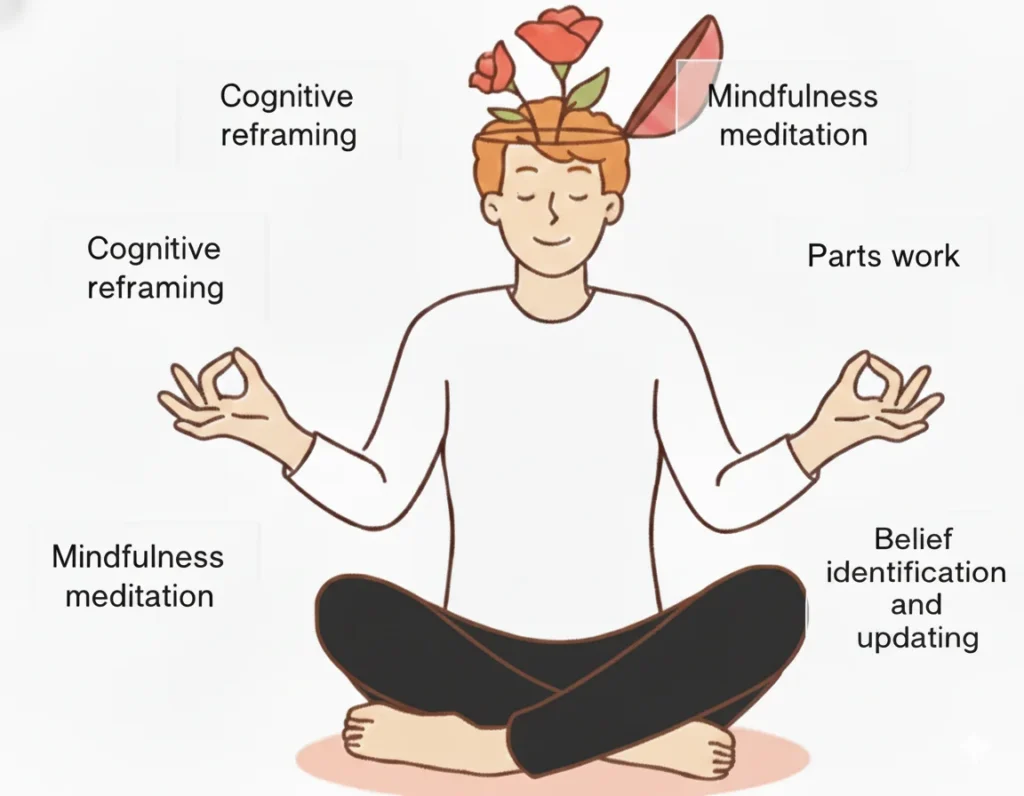
Mind healing approaches include:
- Cognitive reframing: Learning to identify distorted thinking patterns (like catastrophizing, black-and-white thinking, or overgeneralization) and gently challenge them
- Mindfulness meditation: Observing your thoughts without identification or judgment, recognizing that you are not your thoughts
- Narrative therapy: Rewriting the stories you tell about yourself and your past, separating your identity from your experiences
- Parts work: Recognizing that different parts of your psyche hold different beliefs and emotions, and facilitating internal dialogue between these parts
- Visualization practices: Using guided imagery to create new mental associations and rehearse different outcomes
- Belief identification and updating: Uncovering core beliefs formed in childhood or during trauma, examining their validity now, and consciously choosing new beliefs.
Soul Healing Therapy Technique
Soul healing therapy techniques address the deepest layer of your being—the essential self that exists beyond trauma, beyond conditioning, beyond even your personality. This dimension of healing recognizes that emotional abuse and trauma can create a sense of soul loss, disconnection from your essence, or feeling fundamentally damaged at your core.
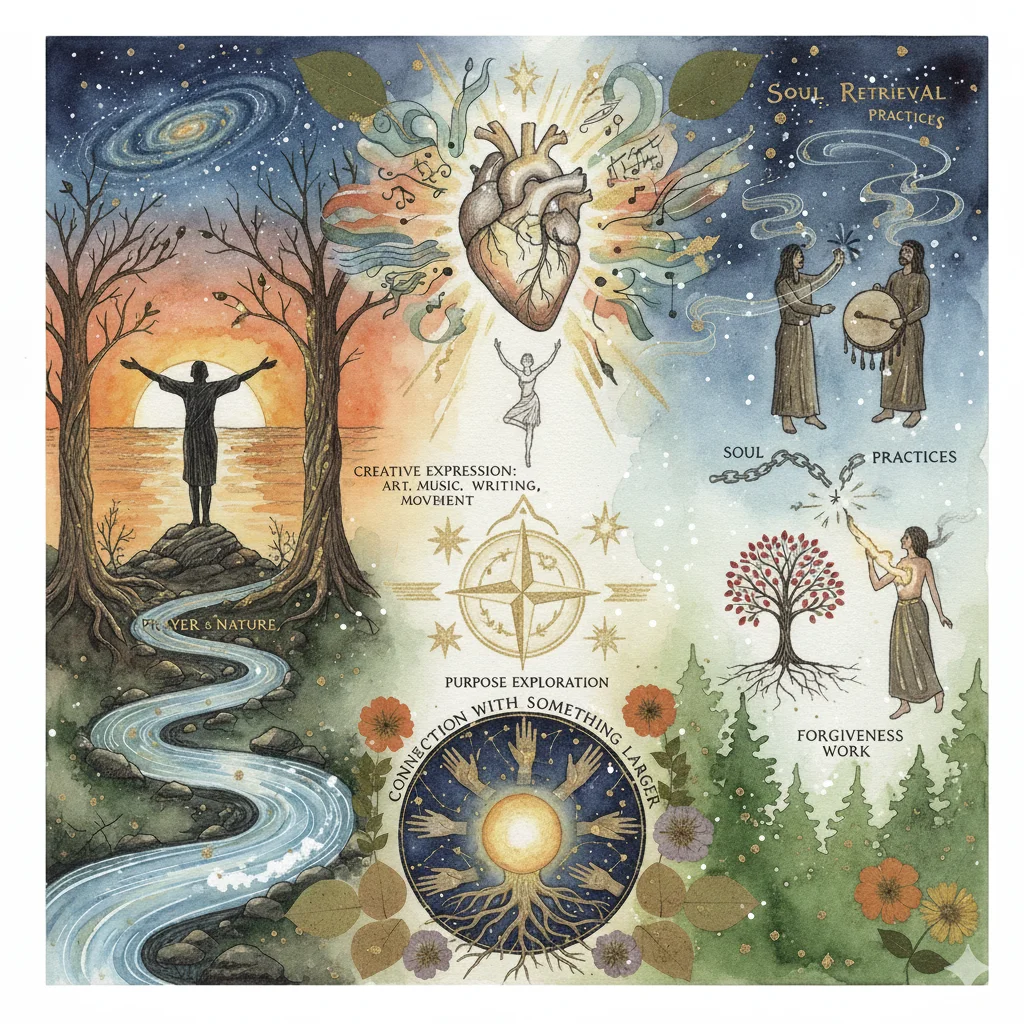
Soul healing approaches include:
- Spiritual practices: Prayer, connection with nature, ritual, or whatever spiritual tradition resonates with you
- Creative expression: Art, music, writing, or movement that allows your soul to speak without words
- Purpose exploration: Reconnecting with what gives your life meaning beyond survival
- Forgiveness work: Not for the perpetrator’s benefit, but to release the spiritual burden you’ve been carrying
- Soul retrieval practices: In some traditions, working with practitioners to reclaim parts of yourself that “left” during trauma
- Connection with something larger: Whether that’s nature, humanity, the universe, or a higher power—reconnecting with belonging
Healing by Touching Techniques
Healing by touching techniques involves both self-touch and practitioner-guided touch to release emotional blockages stored in your body. These approaches recognize that gentle, intentional, consensual touch can signal safety to your nervous system, interrupt patterns of bracing or armoring, and help release stored trauma.
Touch is our first language—before words, before thought, we communicated and experienced the world through touch. For those who experienced abuse or neglect, touch may have become associated with danger, violation, or abandonment. Healing touch techniques work to restore the positive, regulating, and nurturing aspects of touch.

Types of Healing Touch Technique
Self-Touch Practices
You can use gentle self-touch to reconnect with your body and offer yourself comfort and regulation:
- Placing your hand over your heart while breathing deeply, feeling the warmth of your own palm and the rhythm of your heartbeat
- Gently massaging areas of chronic tension in your neck, shoulders, jaw, or temples with slow, conscious pressure
- Using butterfly taps (crossing your arms over your chest and alternately tapping your shoulders) for bilateral stimulation and self-soothing
- Holding your own hand or interlacing your fingers, offering yourself the comfort you might give to a loved one
- Giving yourself a gentle hug by wrapping your arms around yourself and squeezing softly
- Stroking your own arms or legs with gentle, loving touch while saying comforting words
- Placing both hands on your belly and breathing into your hands, creating connection with your center
Self-touch practices are particularly powerful because they teach you that you can be a source of comfort and safety for yourself. You don’t have to wait for someone else to provide soothing—you can offer it to yourself
Energy-Based Touch
In the Body Code and Emotion Code systems, practitioners use magnets along your governing meridian (the energy pathway running along your spine) to release trapped emotional energies. This gentle, non-invasive touch-based approach helps your energy system rebalance naturally after identifying what specific emotions or imbalances need to be released.
Other energy-based touch modalities include:
- Reiki: A practitioner channels healing energy through their hands, either touching lightly or hovering above your body
- Therapeutic Touch: Similar to Reiki, working with your energy field to remove blockages and restore flow
- Acupressure: Applying gentle pressure to specific meridian points to release emotional and physical blockages
- Craniosacral therapy: Extremely gentle touch focusing on the skull, spine, and sacrum to release restrictions in your central nervous system.
Beginning Your Healing Journey
These practices do not work in isolation. They weave together beautifully, each one strengthening and complementing the others. Your healing journey is uniquely yours. You hold the inner wisdom to know which practices to begin with, when to introduce new ones, and when to deepen what already feels aligned.
Remember: Healing is not a straight path. You will not move in a perfect line from broken to whole. Healing moves in cycles. You may revisit familiar emotions at deeper levels, experience both ease and challenge.
